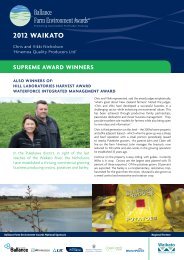Dairy's role in sustaining New Zealand - Fonterra
Dairy's role in sustaining New Zealand - Fonterra
Dairy's role in sustaining New Zealand - Fonterra
You also want an ePaper? Increase the reach of your titles
YUMPU automatically turns print PDFs into web optimized ePapers that Google loves.
It drives many rural economies: “when dairy farmers are smil<strong>in</strong>g, the whole<br />
region smiles”<br />
• Dairy production is hugely important for many regional economies. It <strong>in</strong>jected over $700<br />
million <strong>in</strong>to the Southland economy <strong>in</strong> 2009, with South Taranaki and Matamata-Piako<br />
both receiv<strong>in</strong>g well over half a billion dollars.<br />
• For smaller district economies such as Ashburton ($471 million), Waipa ($361 million)<br />
and Selwyn ($270 million), the value of dairy production, relative to the total size of the<br />
economy, is likely to be significant.<br />
• As noted above, as many as 1 <strong>in</strong> 4 jobs <strong>in</strong> some rural areas are <strong>in</strong> the dairy farm<strong>in</strong>g and<br />
process<strong>in</strong>g sectors.<br />
• The dairy volume expansion over the past decade has delivered an additional $650 of<br />
<strong>in</strong>come per person <strong>in</strong> the Southland region and $590 per person <strong>in</strong> the Canterbury region<br />
above what would otherwise have happened. Northland ($110 per person) and the<br />
Waikato ($270) have also been major w<strong>in</strong>ners.<br />
• A $1/kg <strong>in</strong>crease <strong>in</strong> milk solid prices delivers $170 per person of additional <strong>in</strong>come <strong>in</strong><br />
Northland and Taranaki, $130 per person <strong>in</strong> the Waikato and $140 <strong>in</strong> the Manawatu-<br />
Wanganui region.<br />
It benefits urban consumers too<br />
• Firms benefit from sell<strong>in</strong>g goods and services to the dairy sector. The average dairy<br />
farmer spends well over half of their <strong>in</strong>come on goods and services to support on-farm<br />
operations. Many of these goods will come from urban areas.<br />
• Households benefit from the additional government spend<strong>in</strong>g that is facilitated by the<br />
tax revenue generated by the dairy sector.<br />
• They also pay lower mortgage and bus<strong>in</strong>ess borrow<strong>in</strong>g costs due to the reduction <strong>in</strong> the<br />
current account deficit (and thus the <strong>in</strong>terest rate premium on overseas funds) due to<br />
dairy export revenue.<br />
• The dairy sector’s strong export growth over the last decade has improved <strong>New</strong> <strong>Zealand</strong>’s<br />
balance of trade, and allowed for <strong>in</strong>creased consumption spend<strong>in</strong>g. This export growth<br />
reduced <strong>New</strong> <strong>Zealand</strong>’s net foreign liabilities to GDP ratio by over 1%. Together with the<br />
exchange rate appreciation, this has saved households a cumulative $1.2 billion <strong>in</strong> <strong>in</strong>terest<br />
repayments on foreign debt over the past decade.<br />
Dairy’s <strong>role</strong> <strong>in</strong> generat<strong>in</strong>g growth<br />
E
















